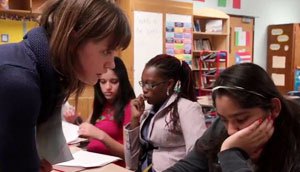New Multimedia Project: ELLs and their Teachers in Poughkeepsie, NY Common Core Classrooms
 As you prepare for a new school twelvemonth, I'd similar to share with you a rich multimedia project that was recently added to Colorín Colorado. The Common Core in Poughkeepsie, NY highlights accurate ways six ESL teachers worked with middle and loftier schoolhouse ELLs to implement Mutual Cadre-aligned lessons. The teachers designed lesson plans with the support of ELL expert Dr. Diane August and David Pook, 1 of the authors of the CCSS in English Language Arts. Those lessons were then filmed with the teachers' ELLs, and the classroom videos showcase the kinds of innovative strategies the teachers used in the lessons to make the CCSS more accessible for ELLs. The projection was a collaboration betwixt Colorín Colorado, the American Federation of Teachers (AFT) and the Poughkeepsie Public School Teachers' Association (ATF) and was fabricated possible by a grant from the AFT Innovation Fund.
As you prepare for a new school twelvemonth, I'd similar to share with you a rich multimedia project that was recently added to Colorín Colorado. The Common Core in Poughkeepsie, NY highlights accurate ways six ESL teachers worked with middle and loftier schoolhouse ELLs to implement Mutual Cadre-aligned lessons. The teachers designed lesson plans with the support of ELL expert Dr. Diane August and David Pook, 1 of the authors of the CCSS in English Language Arts. Those lessons were then filmed with the teachers' ELLs, and the classroom videos showcase the kinds of innovative strategies the teachers used in the lessons to make the CCSS more accessible for ELLs. The projection was a collaboration betwixt Colorín Colorado, the American Federation of Teachers (AFT) and the Poughkeepsie Public School Teachers' Association (ATF) and was fabricated possible by a grant from the AFT Innovation Fund.
In this post, I'll introduce you to the topics of the classroom videos, share classroom strategies y'all can employ that cut across the lessons, highlight some hot topics the teachers mentioned in their reflections, and leave you with my own accept-aways.
Topics of the Classroom Videos
There are three classroom videos available for viewing:
- Answering Guiding Questions with Middle School ELLs - students read an excerpt from the widely acclaimed novel Travels with Charley by John Steinbeck virtually a human who takes a road trip with his domestic dog
- Education of Key Academic Vocabulary with High School ELLs - students read a letter that Captain John Smith of the English Army in Jamestown, VA wrote to Queen Anne in 1616
- Reading Non-Fiction Text with Loftier School ELLs - students discuss the linguistic communication used in Nelson Mandela'due south 1964 Courtroom Speech "An Ideal for Which I am Prepared to Dice."
Each video contains a lesson summary, alignment to Common Core standards, lesson materials, related ELL strategies and resources from Colorín Colorado that support the lesson, a video of the teacher's reflection of the lesson, and a space for viewers to annotate on the lesson.
Classroom Strategies that Cut Across Lessons
 It chop-chop became apparent to me that many of the teachers were using like, effective strategies to engage their ELLs in challenging CCSS-based lessons. Some of the strategies I noticed included:
It chop-chop became apparent to me that many of the teachers were using like, effective strategies to engage their ELLs in challenging CCSS-based lessons. Some of the strategies I noticed included:
- Multilayered vocabulary – teachers focused on key vocabulary from small chunks of text, highlighted words they predicted would be challenging for ELLs, gave definitions and images of vocabulary, provided real-world examples, embedded vocabulary teaching into lessons, had students utilize the vocabulary in sentences, and provided a glossary for the text being read
- Read-alouds – teachers modeled fluency through reading aloud to students, embedding definitions of certain vocabulary words as they read aloud
- Student-centered arroyo – students were grouped in different ways to allow them to practise using the rich language they were acquiring through the lessons
- Support for textual evidence – teachers used a guiding question that provided a central focus for reading and supplementary questions to help them answer the guiding question; students articulated their processes for answering the questions and providing textual evidence
- Comprehension checks – teachers constantly monitored students' work to informally assess and accommodate instruction; teachers monitored students' utilize of vocabulary through discussion, examples, and student generated sentences
Instructor Reflections
The teacher reflection videos are organized around the following topics: teachers' interest in the project, strategies they learned, challenges for ELLs in the CCSS, CCSS professional development for ESL teachers, and CCSS advice for ESL teachers. Several mutual themes surfaced as I watched the reflection videos.
- Teachers described multiple challenges they face in implementing the CCSS for ELLs. One claiming includes finding appropriate texts for ELLs that support the curriculum simply are also attainable to ELLs at different levels of proficiency. Likewise, teachers noted that it is frequently difficult to get into equally much depth as the CCSS ask teachers to, and information technology's challenging to differentiate education across ELLs at multiple levels of proficiency within one classroom.
- Teachers who are "getting their feet wet" with the CCSS should marshal themselves with another colleague who has more classroom fourth dimension and who is proficient at what they do. Teachers should get informal professional person evolution from teachers who are using the CCSS well.
- ESL teachers bring vast knowledge of students to the CCSS classrooms. ESL teachers tend to know the students ameliorate than most other teachers, and the ESL instructor needs to get part of the CCSS chat in schools to share this knowledge of students.
- This project gave these ESL teachers opportunities for clarification on the CCSS from Diane Baronial & David Pook. Teachers described a more positive and confident outlook on the CCSS later this opportunity for professional development to explore and implement instructional strategies such as writing text-dependent questions, embedding vocabulary, and creating glossaries.
My Take-Aways
In my own feel providing professional person development on the Mutual Cadre to content and ESL teachers, teachers who work with ELLs usually similar to run into what strategies really look like with real ELLs at different levels of proficiency. I noticed a high level of discourse among students as they used the vocabulary and academic language they were learning throughout the lessons. This video series provides an within await at how ELLs - some of them long-term ELLs - can be taught within a CCSS framework, and I'll definitely use the videos as an example of how to implement successful strategies to use with ELLs.
In addition to showcasing effective strategies, the projection also highlights the very real struggle that these teachers face. Some were aware of the CCSS but originally faced the standards with trepidation. I'thousand left with the feeling of how it is essential for teachers to interact to help the CCSS succeed (every bit they did in Poughkeepsie for this project). What is also remarkable most this effort is the positive transformation that these classrooms experienced equally a issue of a deeper understanding of the CCSS. Incorporating grade-level content, complex text and high-level discourse into ESL classrooms was certainly a challenge, but as you will hear from the teachers, an doable effort through the back up of other colleagues
So, what can yous practice for your own professional development when you're not working on a project funded by AFT in partnership with national ELL and Common Core experts? The advice to form breezy professional evolution groups with trusted colleagues who are comfy with the CCSS really resonated with me. You, every bit ESL teachers, already take multiple, effective ELL strategies up your sleeves. When you collaborate with colleagues who take CCSS expertise, it tin become a partnership that will certainly pay off!
Source: https://www.colorincolorado.org/blog/new-multimedia-project-ells-and-their-teachers-poughkeepsie-ny-common-core-classrooms
0 Response to "New Multimedia Project: ELLs and their Teachers in Poughkeepsie, NY Common Core Classrooms"
Post a Comment